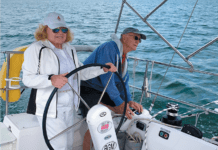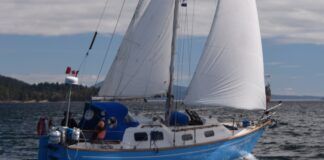Many owners whose boats have cockpit-mounted stereo speakers are totally unaware that they can admit sea water at the rate of almost 1,000 gallons per minute if deluged by a 1-foot wave on deck.
Here’s how to calculate the potential danger: Q = 3,600 (A) (H) in which Q is gallons per minute, A is the area of the hole in square feet and H is the height of water over the hole in feet measured to the lowest part of the hole.
The calculation for 1,000 gallons per minute is predicated on two speakers, each having a 5″ diameter hole. The area of a circle is Pi x R2. The diameter is 5″ or .417 feet. Half of .417 is .208, so the math is:3,600 x 3.14 (.208X.208) x 1= 489 GPM, per speaker.
It is not uncommon to have more than a foot of water on deck. Sea water weighs 8.6 pounds per gallon, so one would get more than four tons of water below per minute with 1′ high waves washing through blown-out speaker cones.
Fortunately, it is relatively easy to install deck plates over existing speaker holes. ABI and Perko make chrome-plated, cast bronze deck plates with screw-in centers in 5″ and 6″ sizes. Beckson has plastic 4″ and 6″ screw-in deck plates.
I bolt the deck plate through the speaker structure and a 3/4″ thick plywood backing plate. Half-inch long screws hold the speaker (generally without the decorative grill) to the backing plate behind the fiberglass cockpit side. A black fiberglass window screen glued to the front of the backing plate makes an attractive speaker grille and will not corrode. With deck plates covering speaker apertures, one can enjoy music on good days while maintaining watertight integrity in heavy weather.
For additional tips on securing your deck, purchase out Bill Seiferts Offshore Sailing, 200 Essential Passagemaking Tips today!





































